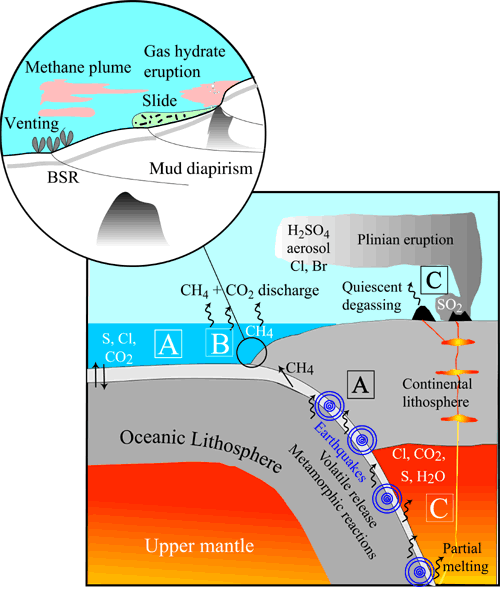 Web Content Anzeige Web Content Anzeige
IntroductionEarthquakes, eruption of magmas and volcanic gases, and submarine fluid seeps reflect transport processes and reactions from the interior of subduction zones. These manifestations are controlled among other parameters by volatiles and fluids transported as components of sediments and altered oceanic crust or are generated in the subduction zones. The devolatilization of water, sulfur, carbon dioxide, and halogens of the subducted slab at volcanoes and vent sites represents a partial return flow of these compounds into the atmosphere and oceans. Together with mantle degassing, continental erosion and sedimentation, this complex material recycling process ultimately controls the chemical evolution of the atmosphere, the oceans, sediments and continental crust as well as the long-term development of the global climate (Berner, 1994). The greenhouse climate of the Mid-Cretaceous and Paleocene, for example, is thought to have been caused by the accelerated formation and subduction of oceanic crust and the associated volcanic CO2 release (Caldeira and Rampino, 1991; Kaiko and Saito, 1994; Larson, 1991). Also, CO2 devolatilization of subducted carbonates, together with enhanced mountain building, may have increased continental erosion rates during the Cenozoic (Caldeira, 1992) drastically changing the input of weathering products to the oceans over millions of years. Short-term climate changes can also be triggered by processes within subduction zones as through the release of methane from gas hydrates at active margins. Paull et al. (1991) had speculated on such a role of gas hydrates initially. Subsequently, isotope data of marine biogenic carbonates and organic tissue, for instance, were implicated in the distinct temperature excursion of Late Paleocene age -lasting about 20,000 years- to have been caused by the decomposition of methane gas hydrates (Dickens et al., 1995; Norris and Pöhl, 1999). Most recently, Kennett et al. (2000) showed that, in the Santa Barbara Basin over the past 60,000 years, all interstadials -on a millennial time-scale- are characterized by massive carbon release from decomposing gas hydrates due to changes in bottom water temperature and circulation pattern. Volcanic eruptions and magmatic degassing at subduction zones release enormous amounts of sulfur, which reach the stratosphere and are converted into sulfate aerosols (Graf et al., 1997; Schmincke, 2000), thereby drastically changing the radiation budget of the Earth so that its surface cools down, decreasing the average annual temperature significantly, a process partially responsible for inter-annual climate variability as exemplified more recently by the 1991 eruption of Pinatubo volcano, Philippines, (McCormick et al., 1995). The return flow of material and the impact of fluids and volatiles at subduction zones also play an essential part in the generation of natural disasters. The largest volcanic eruptions, earthquakes, and slumps occur in the arc region of subduction zones where they endanger some 70% of the world population living in coastal regions. Fluids are transferred from the subducting plate into the mantle wedge and hence upward by magma, some of which ascend to build highly explosive volcanoes. The magnitude of an earthquake may be related to the fluid content of down-going sediments and to the depth of the seismogenic zone. Many large-scale slumps occur at tectonically over-steepened convergent margins and can cause disastrous tsunamis (Monastersky, 1999). The formation of slumps may be influenced by diagenetic methane generated in the fore-arc sediments which, under certain pressure and temperature conditions, reacts with water to form gas hydrates (Sloan, 1998), thereby changing the basic sedimentary fabric and making it prone to failure (Rothwell et al., 1998). The long- and short-term development of the Earth´s climate, the geochemical evolution of the hydrosphere and atmosphere, and the causes of natural disasters, are all connected with the return flow and impact of volatiles and fluids from subduction zones. Thus, the multi-disciplinary analysis of these volatile phases and their complex effects on the exosphere, is an ambitious undertaking, and one of the highest priority objectives of modern geoscience. It constitutes the central scientific concept of the Sonderforschungsbereich (SFB 574). The major volatile transport loops for input and output are illustrated in Figure 1, as well as the major reservoirs and their interactions. The insert shows manifestations of submarine volatile return fluxes through venting, mud diarism, and gas hydrate dynamics. The letters A, B, and C denote the overarching themes under which all subprojects are grouped together. The processes controlling climate evolution on different time scales are not known in sufficient detail. Only a better understanding of the complexity and interactions of return and release mechanisms, as well as the quantification of the material flows in subduction zones, can yield more precise and reliable predictions on different time- and space-scales. A better understanding of the system Earth based on such results will help in developing protective measures and evaluating natural hazards, a prerequisite to mitigate natural disasters.
Figure 1: Material transport and transformation in subduction zones: Long- and short-term trends of the Earth's climate, geochemical evolution of the exosphere, and the causes of certain natural hazards are related to the reactions of volatiles and fluids in subduction zones. Partial return flux is through dewatering at the deformation front of accretionary complexes, through mud diapirism (incl. gas hydrates formation and destabilization; enlarged inset), and through volcanic arc magmas. The process of volatile return encompasses different material reservoirs, transport loops, and reactions for H2O and the S-, C-, and Cl-compounds. This new responsibility for the geosciences has to be approached through new efforts and methods: submarine and subaerial observatories, time-series type measurements and analysis of processes, as well as new approaches in modelling, all of which complement the traditional methods of marine and geologic research. |
 Events Events
Kieler Wissenschaftler fühlen den 'Puls der Erde' Wie funktioniert die Recyclingmaschine der Erde?Nach elf Jahren endet der Kieler Sonderforschungsbereich 574 zu Subduktionszonen Final colloquium of SFB 574 Teilprojekt ÖffentlichkeitsarbeitMEERESFORSCHUNG FÜR MICH UND DICH |
|
©SFB574 // Wischhofstrasse 1-3 // D-24148 Kiel // T. +49 (0)431 600 1413 // elange [AT] geomar.de






